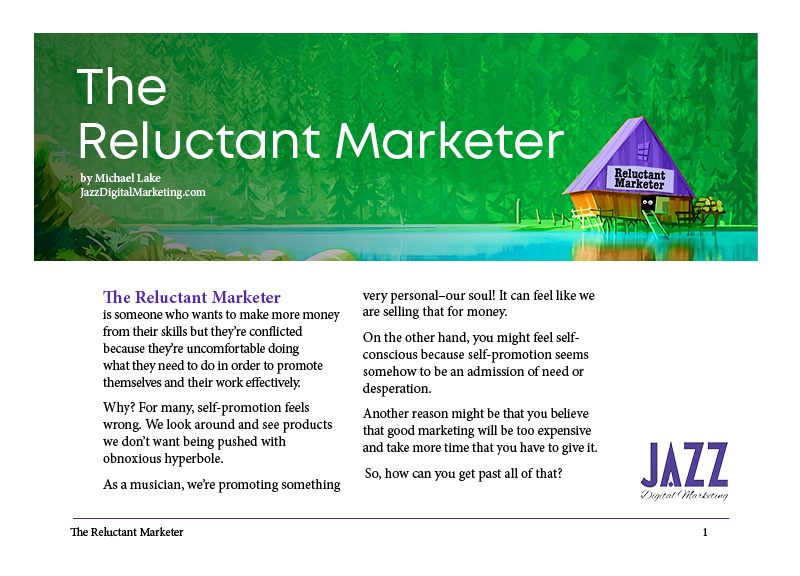I received an email a week ago from the video platform Vimeo letting me know that my annual subscription is about to renew and they will be taking $600 from my registered payment method.
I give them credit for letting me know since it is not uncommon these days for companies to quietly remove the money from your card on file, hoping it doesn’t attract too much attention. Shhhhh…
I thought about that number and realized that my needs from Vimeo have diminished since posting hundreds of videos for my Pocket Jazz and Improvisation Savvy courses, and all those video interviews and videos embedded on my sites and those that I build for others. I realized that I should subscribe to a lessor subscription plan from Vimeo.
So I looked for my options relative to lower-level subscriptions from Vimeo. Looking through my account, the only options I found were upgrades to my current plan. According to the chart, I was at the lowest level.
But I knew that was not true. Vimeo offers a free account and entry-level paid accounts. Where were those options listed on my page? Well, I found them by going to vimeo.com using a private incognito page. There they were, hiding: free, and two other levels below mine.
I reached out to Vimeo on a support ticket and heard nothing after several days. I went back into their support area and saw that they had a link to set up a phone call with an Account Executive, so I scheduled a meeting. I completed the form and explained the reason for my call. 30 minutes before the call, Samantha, the Account Executive said she would not help me with billing questions, and simply gave me an email address for the people she said could help. I’ve emailed and days later I am still waiting to hear back from someone.
That’s the backdrop, but the important point I want to make is about today’s abysmal state of customer support and the tactics companies go through to keep a tight grip on your money. Exhibit A today is Vimeo, but Vimeo is far from being the only example of poor customer service.
There are exceptions. For example, I canceled my Amazon Audible account today, and Amazon made it very easy. Yes, they threw several discount offers, pause options, “are you sure” confirmations, and emails asking me to reconsider, but that’s okay. In the end, they let me manage my Audible expenditure based on my evolving needs rather than their bottom line.
Call the Reluctant Marketer naive. He has trouble understanding why so many companies go to the lengths they do to get money out of your bank account and then make it so difficult to end or downgrade the relationship.
I would like to propose a standard of conduct for online merchants. The purpose of this standard is to prioritize the needs of the customer over the needs of the merchant. After all, without the customer, the merchant ceases to exist. Too many companies forget that their customer’s satisfaction is what keeps their business running into the long-run.
The standard I am proposing is that online merchants shall:
- Provide ease of cancellation or downgrades equal to the ease of purchasing or upgrading.
- Never take a recurring subscription payment without at least one week’s notice to the customer via their preferred channel along with links to canceling and downgrading the service within that notification.
- Empower their salespeople to help clients make changes to their billing and subscriptions. Consider it to be a fireable offense for a salesperson to refuse help to a customer wishing to cancel, make a downgrade, or ask questions about their account. That help can take the form of enthusiastically and immediately transfering the customer to a live person in billing who can accommodate their needs.
Will merchants make less money if they follow this standard of conduct? Perhaps, in the short term. But good business is built on the long term, and competitors are around every corner in a free market.
You may remember the stories of a young Zappos.com. They were an early online seller of shoes and their customer service was legendary. Stories of customer service representatives sending flowers to customers and giving no-question refunds for well-worn shoes were stories repeated in business conferences throughout the world. We were told THAT was what we should all aspire to.
What happened? Competition happened. Large corporations with quarterly expectations taking over online commerce happened. And the faded memory of Zappos and others like them happened.
Zappos and others like them were smart enough to realize that customer service can be a profit center. The current view of customer service for too many companies is that it is purely a cost and therefore, the number one job is to reduce that cost as much as possible. Limit support hours, enforce an inefficient ticketing system, hire as few poorly-paid people as possible, and train your employees to silo responsibilities.
Look, if you sell a truly valuable product or service, taking the trouble to do what I am suggesting will only grow your business in the long run. But if your myopic view of this quarter’s earnings demand that you make cancellations, refunds, and subscription downgrades an Olympic feat of customer persistence, I am rooting for your to lose the long game. And that includes you, Vimeo.








